Named after King George II of England, this state is rich in diversity. It is home to various turtle species that include land, sea, semi-aquatic, and freshwater turtles. Some of these species are predominantly in Georgia, but others are also found in other states.
How many turtle species are there in Georgia?
Georgia is home to close to 40 turtle species. They vary from land, aquatic to semi-aquatic. While some are present in significant numbers, other species are of special concern while others are endangered.
Turtle species differ in size when mature, physical appearance, nesting season, incubation period, and lifespan, among other features. Let’s have a look at 10 of the most prominent turtles you will find in Georgia.
1. Eastern Box Turtle

We start with these turtles bearing a dome-shaped shell. The shell has markings whose colors range from black to yellow to brown. When it comes to the skin, it has patterns that look like spots. A distinctive feature of Eastern Box turtles is that they have four toes in their hind limbs.
The turtle gets its name from its prevalence along the Eastern part of the United States. They are considered terrestrial, spending most of their lives on land. This means that they are more active as they are not limited to water sources.
These turtles can survive in a variety of environments but mainly in open hardwood forests and grasslands. As such, these turtles are pretty common in Piedmont.
Eastern box turtles are relatively small, with a mature turtle weighing 1-2 pounds and measuring 4-6 inches long. They are omnivorous, with their diet consisting of insects, vegetables, fruits, and meat. These box turtles are known to live between 50 and 100 years.
In terms of conservation, Eastern box turtles are considered a vulnerable species in Georgia.
2. Red-Eared Slider
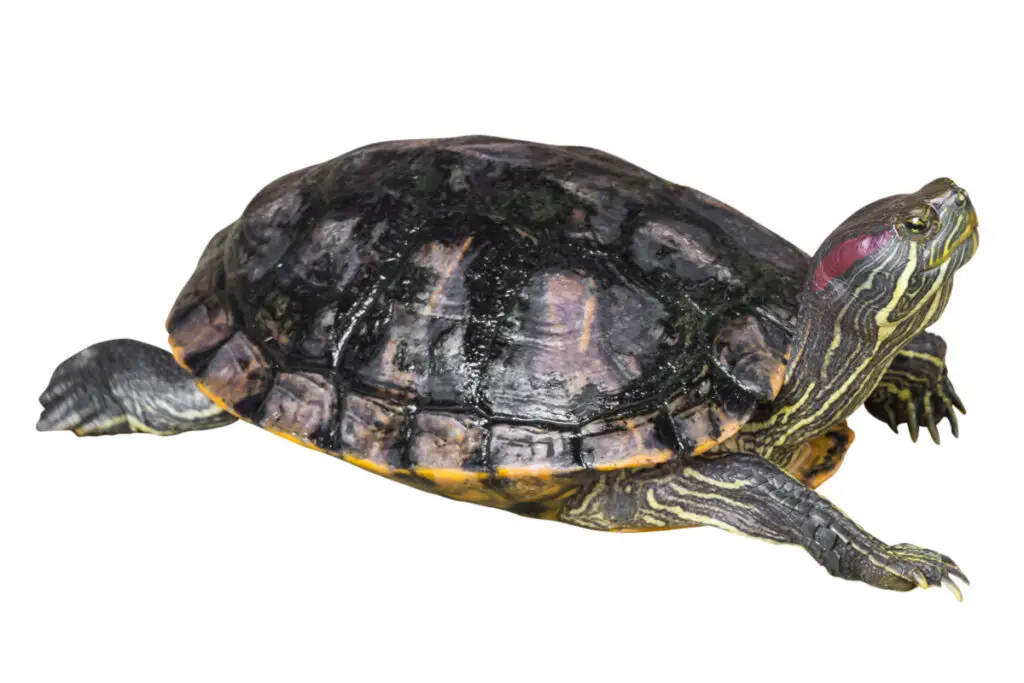
Another common turtle species in Georgia is the Red-eared slider. It is native to the southern part of the US and northern Mexico and bears the scientific name Trachemys scripta elegans.
They derive their name from the clear red strip near their ears and their ability to slide under the rocks when disturbed. The colors of their skins and shells vary from red to orange and, at times, yellow. Their shells also have some black patterns.
They are semi-aquatic, meaning that they can survive on both water and land. In Georgia, they mainly inhabit shallow creeks, ponds and marshes, and other places near such.
While their sizes vary, most Red-eared sliders range between 7-12 inches and weigh around 7 pounds. They have a lifespan of between 30 to 40 years. As omnivores, they mainly feed on snails, vegetables, fish, insects, and meat.
The red-eared slider’s nesting period is between March and June. A clutch can bear up to 30 eggs, with bigger slider females laying more eggs. Incubation takes around 75 days, and the sex of the hatchlings depends on the temperature.
3. Alligator Snapping Turtle
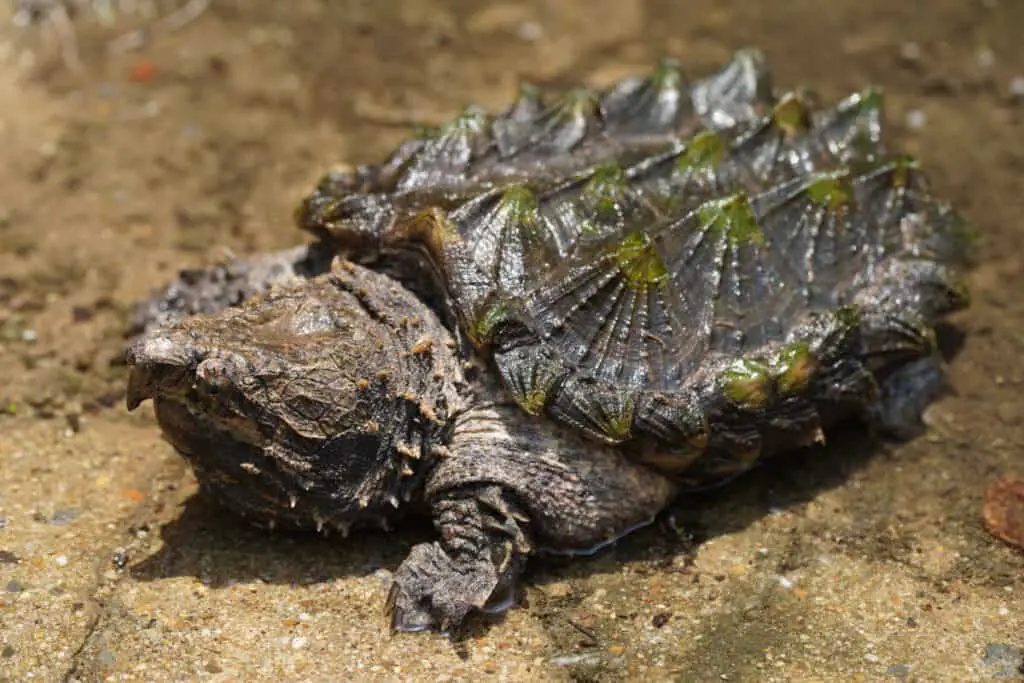
Next, we have the alligator snapping turtle that derives its naming from snapping its beak-like mouth. This turtle is usually black or dark brown with spiky and rough shells bearing three ridges that run to the back from the front.
Unlike other turtles, the eyes of the alligator snapping are on the sides of its head. Another distinct feature is that their thick tail has scales.
The turtle is aquatic, often be found in shallow ponds and lakes. An alligator snapping turtle is known to hunt its prey by sitting at the bottom of a lake with its mouth wide open for trapping prey with the tongue. It is mainly carnivorous and often feeds on fish and other small aquatic animals.
The lifespan of an alligator snapping turtle is between 60 and 70 years which is longer than most of the other turtles in Georgia. Their scientific name is Macrochelys temmincki.
These turtles do not stay small as they, on average, measure between 25 and 27 inches. There are cases where they can grow to 30 inches long. In terms of weight, these turtles can weigh up to 200 pounds, making them one of the heaviest turtle species in Georgia.
Alligator snapping turtles are the biggest of all the freshwater turtles in Georgia. Their size, when mature, and aggressive nature might be why they are not a popular turtle pet species among pet owners.
They are considered a vulnerable species not only in Georgia but worldwide. Females lay one clutch per year, and it contains between 8-52 eggs.
4. Common Snapping Turtle
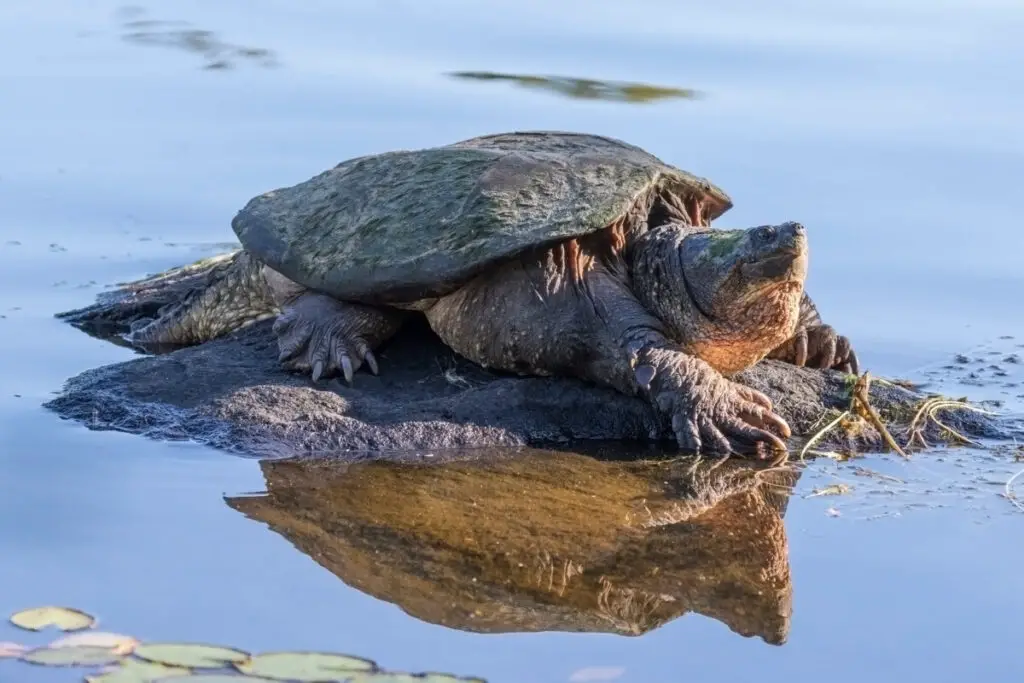
This turtle has the same beak-like mouth as the alligator snapping turtle. However, the Common snapping turtle is less aggressive and smaller.
A distinct feature of this turtle lies in its tail. The tail grows to the length of their shell, and it has saw-toothed keels.
It has a black shell, and the skin has a dark brownish color. Common snapping turtles are aquatic and are primarily found in shallow swamps, ponds on streams. They also prefer soft mud or sand with submerged trunks in which they hide.
Scientifically known as Chelydra serpentine, these turtles grow to a carapace length of between 12 to 15 inches. Their lifespan ranges between 25 and 30 years. Common snapping turtles are omnivorous, and as with other wild turtles, they hunt for their prey.
They also feed on the lush aquatic vegetation in their habitats and are common in almost all areas in Georgia.
In Georgia, these turtles are considered a common delicacy and thus are hunted by humans for food. They are, however, not endangered. Common snapping turtle’s nesting period is between May and July, with the incubation period between 70 and 100 days.
5. Eastern Mud turtle
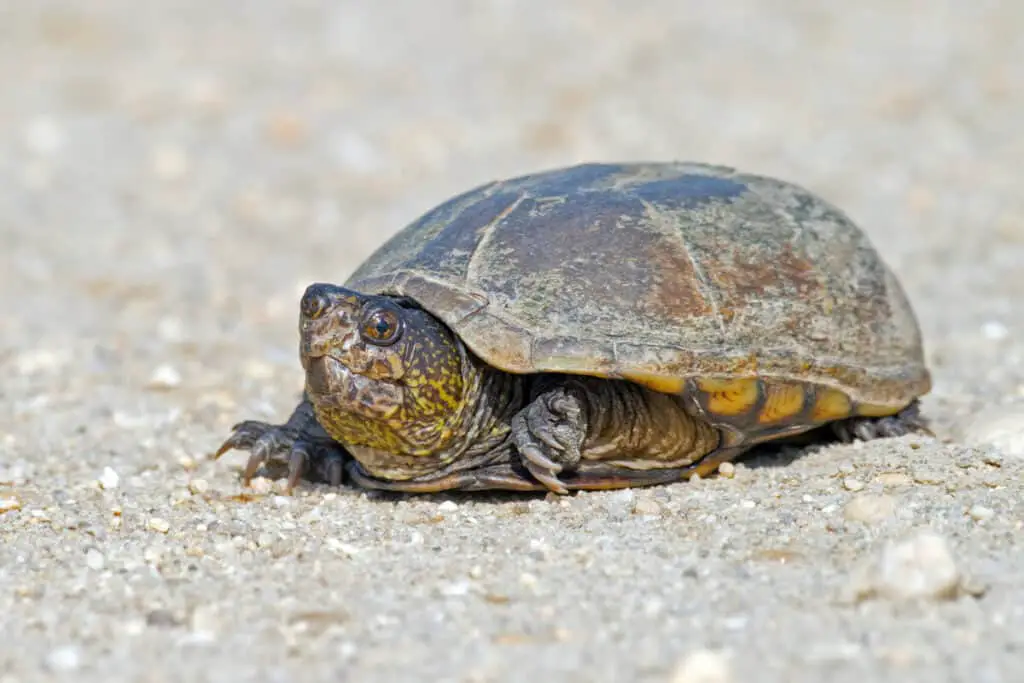
This is one of the soft-shelled turtles. The shells of Eastern mud turtles range in color from black to dark brown. Their lower part is lighter and plain in color. A distinctive feature is the white or sometimes yellow stripes on their heads.
Its shell’s upper part is smaller than the lower part. Their shells are devoid of any marks or patterns, which may make it hard to identify them.
A mature eastern mud turtle weighs 0.19-0.6 pounds and measures between 7.5 to 10.2 inches. Their lifespan ranges between 30 and 50 years.
As their name suggests, their habitat is warm aquatic bodies and in marshes and swaps. The diet is carnivorous, consisting of fish, insects.
6. Bog Turtle
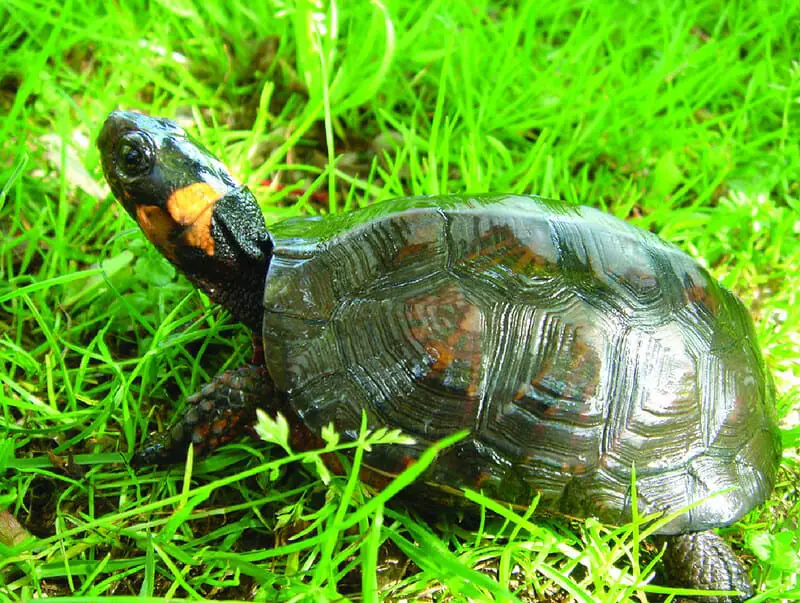
Bog turtles are considered one of the smallest turtles, only reaching between 3 and 4 inches when mature. Besides the small size, the turtles can also be identified based on their unique red, yellow or orange colored blotch behind the eyes on both sides of its head.
This turtle is semi-aquatic, with a greater preference for wet areas with lots of vegetation. As such, they are common in muddy areas, wetlands, and meadows. Because it is omnivorous, it feeds on a large variety of meat, insects, and vegetation.
The life expectancy of a bog turtle varies between 30-40 years. Nesting happens between May and July, and the incubation takes 80-90 days. With the scientific name Glyptemys muhlenbergii, they can lay up to 4 egg clutches in a year, with each clutch having 1-6 eggs.
Bog turtles are one of the most critically endangered species in Georgia due to habitat destruction. As a result, the state of Georgia has organized a program dubbed the “bog turtle head start program.”
This program is intended to raise the population by having the females hatch their eggs in captivity, and the young ones are then reared to maturity in conservation programs.
7. Spotted Turtle
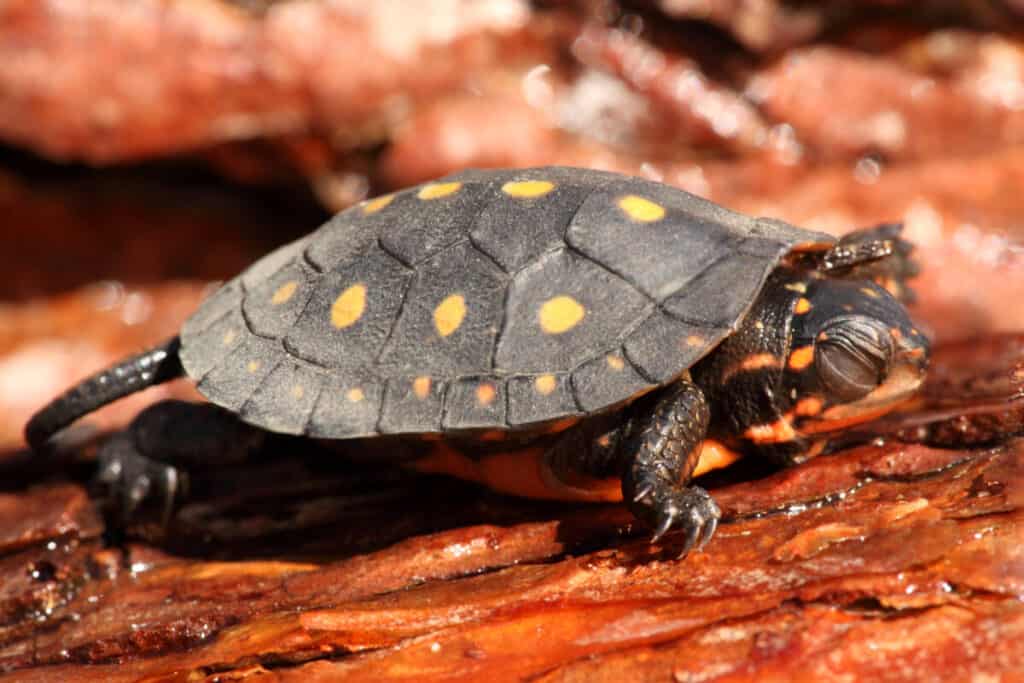
Just like the bog turtle, the spotted turtle is considered to be a critically endangered species. The main threat is habitat destruction.
They are an easy to identify turtle species because of their greyish carapace with bright yellow spots. The spots can also be seen on the head, neck, and limbs. Spotted turtles are omnivorous, feeding on small invertebrates, insects, and aquatic vegetation.
Due to its semi-aquatic nature, the turtle inhabits marshes, wet meadows, and flooded forests. They are scientifically referred to as Clemmys guttata.
In terms of their size, they only grow up to 3-4 inches, with females growing bigger than males. Maturity occurs between 7-15 years, with the female maturing faster. In addition, they have a shorter lifespan of up to 30 years.
When it comes to reproduction, female spotted turtles lay a maximum of 2 clutches in a year. A clutch carries between 3-5 eggs. Their nesting period is between May and July, and their incubation period is 80-90 days.
As an endangered species, it is essential not to interfere with the turtles if you spot them.
8. Gopher Tortoise
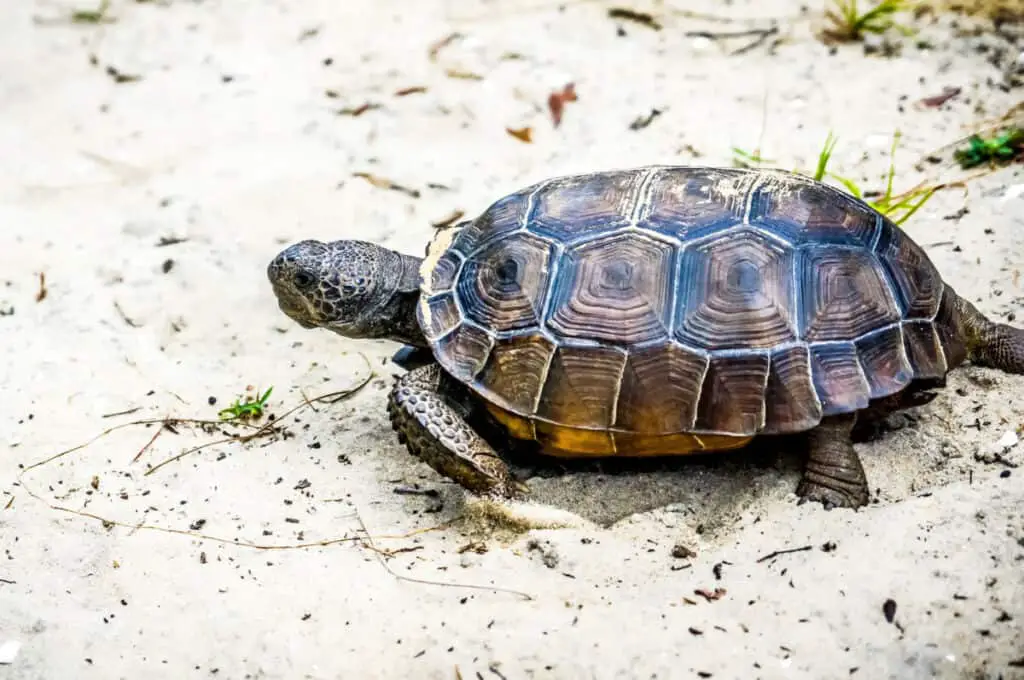
Gopher tortoises are considered to be one of the key species in the Georgian longleaf pine ecosystem.
The tortoise is terrestrial and endemic to the southern part of Georgia. It is the only land tortoise native to Georgia. These tortoises inhabit dry loose sandy soils and lives in burrows. They are also common in grasslands and other areas with low vegetation. Known to dig deep burrows, gopher turtles provide shelter for many other animals.
Unlike most of the turtles found in Georgia, Gopher tortoises are plain-looking. They have a dark brown or grey carapace, with the lower side being slightly lighter in color.
A mature gopher tortoise measures 10-15 inches and weighs up to 9.5 pounds. Their diet is herbivorous, mainly consisting of grass, berries, and mushrooms.
These terrestrial turtles have a lifespan of up to 60 years. Their nesting period is usually between May and July. On average, their incubation takes 80-110 days. As with all other turtles, gopher tortoises do not have maternal instincts, and they leave the eggs to hatch on their own.
Gopher tortoises are considered vulnerable. There have been several conservation measures in Georgia to aid their survival. The main threat to their existence in Georgia has been human predation, habitat destruction, and environmental degradation.
9. Alabama Map turtle
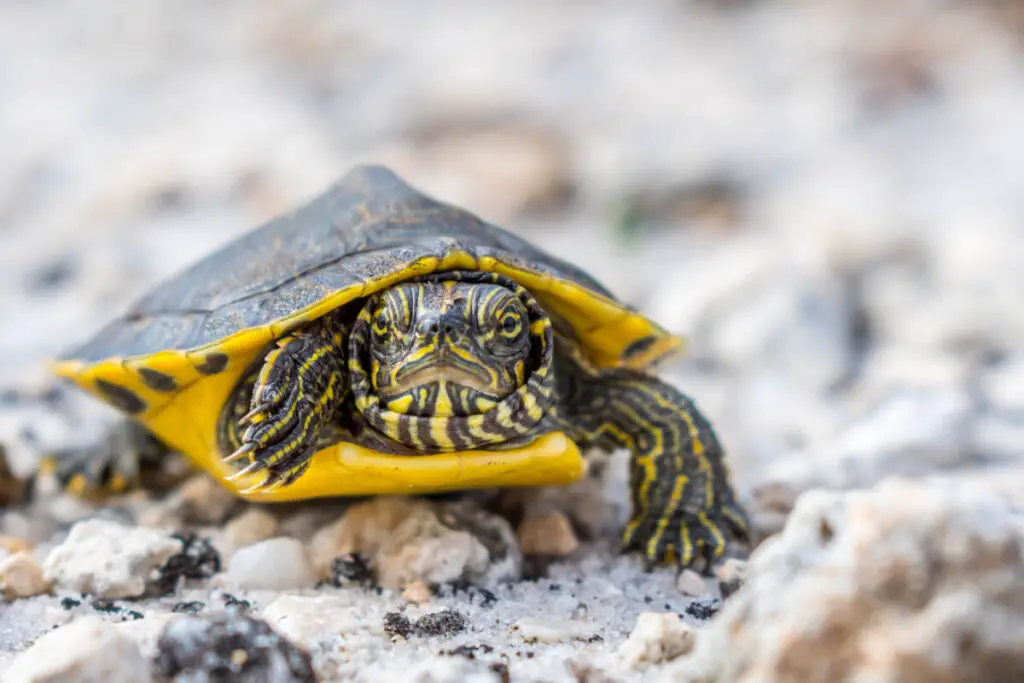
Scientifically, they are known as Graptemys Pulchra. As aquatic reptiles, Alabama map turtles are predominantly found along slowing-flowing rivers and large creeks in Georgia. They also love inhabiting areas with fallen branches and vegetation with basking spots.
Map turtles range from green, brown, to black. The carapace has map-like patterns, which is the reason why they are called map turtles. Its plastron is yellow. The neck and limbs of this map turtle are green with marking on thin yellow lines.
Alabama map turtles have an extensive line formed of knobbed keels, but this tends to disappear with age.
When mature, the turtle measures between 3.5 inches and 10.8 inches. Their diet is omnivorous and mainly composed of insects, vegetation, and freshwater mollusks mussels. Alabama map turtles have a lifespan of 30 – 50 years. Maturity takes 14 years in females and 8-10 years in males.
A female lays 1-2 clutches in a year with an average of about five eggs. Alabama map turtle is considered an endangered species as a result of the destruction of their habitat.
10. Barbours Map turtles
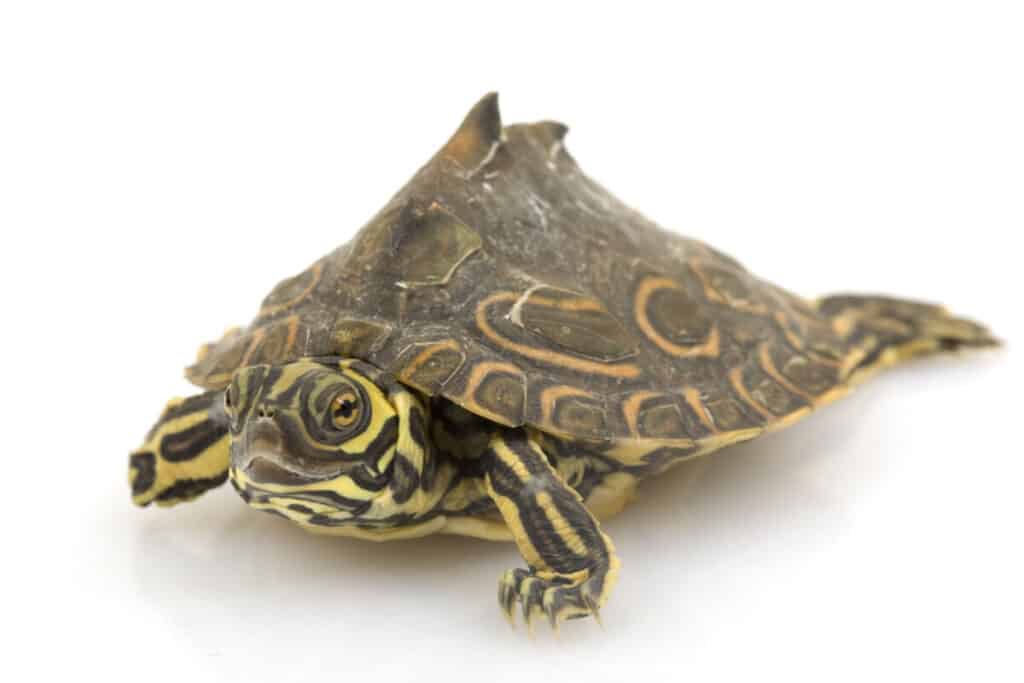
Barbours turtles are majorly terrestrial residing close to freshwater bodies. They are endemic in stagnant or slow-moving rivers and ponds with lots of vegetation around. Besides Georgia, they are also native to Alabama and Florida.
The turtle, scientifically known as Graptemys barbouri, has a black or at times dark brown shell with markings ranging from yellow to green. It has broad patterns and wide marks on its neck, tail, and hind limbs. Their shells have distinctive spikes that vary in size from one turtle to another, but all have dark tips.
Females Barbours map turtles are considerably larger than males, sometimes growing twice as big as their male counterparts. A mature female can grow up to 8-10 inches while a male barely reaches 5 inches’ length.
Barbours map turtles are omnivorous, with the diet mainly consisting of insects, fruits, meat, and aquatic vegetation.
These turtles have a lifespan of between 30 and 50 years. Females lay up to 3 clutches a year, with each clutch holding between 7-10 eggs. Maturity in females takes up to 14 years, while it takes between 3-5 years in males.
Other Turtle Species Found in Georgia
Apart from the above turtle species that we have explored in detail, below are more species found in Georgia:
- Painted Turtle
- Striped Mud Turtle
- Loggerhead Sea Turtle
- Diamondback Terrapin
- Chicken Turtle
- Florida Softshell
- Kemp’s Ridley
- Eastern River Cooter
- Florida Redbelly Turtle
- Florida Cooter
- Gulf Coast Spiny Softshell
- Hieroglyphic River Cooter
- Common Musk
- Leatherback Sea Turtle
- Midland Painted Turtle
- Yellowbelly Slider Turtle
- Loggerhead Musk Turtle
- Green Sea Turtle
Threats Faced by Turtles in Georgia and Conservation Measures in Place
While some of them are flourishing, there are increasing threats facing some turtle species in Georgia. Below is a list of the most severe threats and the conservation measures that have been implemented.
1. Human Interference
Human activities have been a significant contributor to the threats faced by sea turtles in Georgia. Since most turtles nest at the beach where there is a lot of human activity, it is inevitable for conflicts to arise.
Increased human activities at the beaches have led to the destruction of nesting sites for turtles. As a result, there has been an interference with the turtles’ breeding cycles and, ultimately, their population.
Most turtles are forced to seek alternative breeding sites that are unsafe for their eggs and hatchlings. They sometimes result in nesting quite a far distance from the water bodies with less human activity. However, this makes it hard for the hatchlings to get to the waters once they have been hatched.
Most end up dying or being killed by predators before reaching the water bodies.
To address this, there has been continued sensitization to the general public in Georgia on the need to take care of the turtles’ nesting sites. In some severe cases, measures have been implemented to limit human access where these turtles nest. This has helped to some degree, although there is still more that needs to be done.
2. Beach Erosion and Accretion
There are areas in Georgia where beach erosion has destroyed turtle’s suitable nesting areas. The erosion washes away the turtle’s nesting and leaves the eggs vulnerable to predators.
The leading cause of beach erosion is either natural coastal processes or as a result of human activities such as coastal development.
Accretion is the deposit of sea sediments. It destroys turtle nesting areas by either uncovering the burrowed eggs before they hatch or by covering them deeper into the sand, thus making it hard for the hatchlings to reach the surface.
Measure taken to deal with accretion include beach armoring and beach nourishment. Beach armoring is the action of fortifying the shorelines to reduce erosion. This is, however, majorly done to safeguard the coastline structures and not save the sandy beaches.
Some of the common ways of beach armoring include sea walls, sandbag installations, groins, and jetties.
In some cases, beach armoring has caused more harm than good. The structures put up block hatchlings from accessing the sea or the turtles’ access to nesting sites. The debris that results from the structures may also destroy the eggs and hatchlings.
Beach nourishment, on the other hand, means replacing the beach sand lost through erosion. A significant problem with this is that it can bury the hatchlings and nesting sites. The sand brought may be different from the native one, which may affect nesting. The use of heavy machinery during this process may also destroy the nesting sites.
3. Artificial Lighting
Developments along the coast of Georgia have led to many lighted structures coming up. This has in some ways contributed to the interruption of the breeding cycle in turtles. Emergent hatchlings use visual responses to guide them towards the sea.
Artificial lights disorient hatchlings, who end up losing their way. Therefore, they become vulnerable to predators and other dangers. Adult turtles have also been known to avoid nesting sites with bright artificial light.
To curb this, there have been efforts to promote beach darkening in well-known turtle nesting sites. In addition, isolating the nesting sites from the rest of the beach has led to some success.
4. Shrimp fishing
Being one of the most profitable fishery businesses in the US, shrimp fishing has contributed to decreased turtle population in Georgia. Adult and young turtles alike are captured by trawls being towed behind shrimping vessels.
The trawls are heavy meshed bags with an opening at the mouth. The weight is meant to ensure that they sink to the bottom. Turtles resting or feeding deep in the sea are captured together with the shrimps. They are later cast out as unwanted bycatch.
Shrimp fishing has been known to displace turtles from their current habitat to other areas that are not native to them. Apart from that, most turtles have been injured or killed by trawls during fishing, posing a significant threat to their populations.
To address this, the National Oceanic and atmospheric administration issued a final ruling that requires skimmer trawl vessels to be fitted with a turtle excluder device. This is to be done for skimmer trawlers that are 40 feet and greater in length. The device will enable a turtle to escape when it is caught in a trawler.
This ruling is expected to significantly reduce the bycatch mortality in turtles while still facilitating shrimp fishing. The rule was to take effect by 1st April 2021.
If you love turtles and are in Georgia, there is a great need to join hands with conservation agencies in order to promote turtle conservation measures.
Conclusion
With over 40 turtle species, Georgia is one of the richest states in terms of turtle diversity. Due to its significant ecological factors and geographical location, the turtle population has thrived quite well in the area.
Georgia has experienced a constant reduction in the turtles’ population due to natural and human factors. If left unchecked, more of these species will be critically endangered or even become extinct.
There is hope as consistent conservation efforts are gradually helping improve the population of some of the most critically endangered species. By sensitizing the general population, especially beach users, people will care more about turtles’ nesting spots.